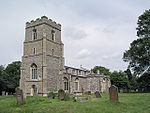Devil's Dyke, Cambridgeshire
Ancient dikesAnglo-Saxon sites in EnglandArchaeological sites in CambridgeshireArchaeological sites in SuffolkArchaeology of the kingdom of East Anglia ... and 6 more
Fortifications in EnglandLinear earthworksRuins in CambridgeshireScheduled monuments in CambridgeshireSites of Special Scientific Interest in CambridgeshireSpecial Areas of Conservation in England

Devil's Dyke or Devil's Ditch is a linear earthen barrier, thought to be of Anglo-Saxon origin, in eastern Cambridgeshire and Suffolk. It runs for 11 kilometres (6.8 mi) in an almost straight line from Reach to Woodditton, with a 10-metre-high (33 ft) ditch and bank system facing southwestwards, blocking the open chalkland between the marshy fens to the north and the formerly wooded hills to the south. It is a Scheduled Monument, a biological Site of Special Scientific Interest and a Special Area of Conservation.
Excerpt from the Wikipedia article Devil's Dyke, Cambridgeshire (License: CC BY-SA 3.0, Authors, Images).Devil's Dyke, Cambridgeshire
Devil's Dyke, West Suffolk
Geographical coordinates (GPS) Address External links Nearby Places Show on map
Geographical coordinates (GPS)
| Latitude | Longitude |
|---|---|
| N 52.232 ° | E 0.359 ° |
Address
Devil's Dyke
Devil's Dyke
CB8 0TQ West Suffolk
England, United Kingdom
Open on Google Maps








